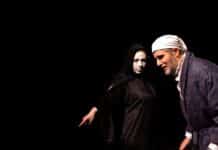It is astonishing to think that Jonathan Larson, the visionary composer, the voice of a new generation, the tunesmith who brought rock to musical theater in his iconic show RENT, would be 65 this year.
To judge by his Tick, Tick… BOOM! now playing at the Greenbelt Arts Center, he wouldn’t have liked the idea much. The semi-autobiographical show portrays his anxiety about turning 30 without having yet achieved his dream of having a show produced on Broadway. On the other hand, in reality, Larson achieved success and fame beyond his wildest imaginings, with RENT winning the Pulitzer Prize for Drama, Tonys for Best Musical, Best Score, and Best Book, running for 12 years straight on Broadway, and being produced, toured, and revived continuously ever since. Yet he never got to see his triumphant achievement because he died, suddenly and tragically, the night before the show opened.
It may seem as if Larson appeared like a flaming meteor in the sky and then burned out just as fast, but like all great artists, this overnight success was years in the making. Tick, Tick… BOOM! is the story of his struggle. The show is a fully-staged three-actor version from 2001 of a one-man “rock monologue” Larson performed from 1990 to 1993 while working on what he hoped would be his breakthrough musical. The songs are a fascinating mix of the flawed work of a young composer with flashes of the genius that animated his later work.

The show follows his own life fairly closely and contains characters based on his friends and lovers. The main character, “Jon” (Michael McCarthy), living in a squalid fourth-floor loft in SoHo on the eve of his 30th birthday and a workshop of his new show, SUPERBIA, wonders what to do if it does not get picked up for production. Should he move away from the city and start a family with his girlfriend, Susan (Elizabeth Suzanne)? Should he give up and go corporate, selling out for a BMW and an apartment with a doorman and a stainless-steel kitchen? Today, his problems seem almost luxurious — he actually has the choice of whether to live in poverty to pursue his art, sell out for a cushy job, or settle for love and a home and a family. Many people in their 20s or 30s today aren’t lucky enough to have that trilemma — they barely survive paycheck to paycheck because they don’t have any other choice.
The opening number, “30/90,” risks being juvenile in its self-absorption. The assumption seems to be that that turning 30 puts one foot in the grave:
Why can’t you stay 29
Hell, you still feel like you’re 22
Turn thirty 1990
Bang! You’re dead,
What can you do?
And yet perhaps anyone over that age, looking back, can recall similar feelings.
The next number, “Green Green Dress” seems similarly adolescent — a song about Jon’s girlfriend’s dress that turns him on, and that he wants to take off. The only hint of character revelation is that she would like to talk, go for a walk, hear him laugh, but he can only think of one thing.
“Johnny Can’t Decide” paints his problem in similarly simplistic terms:
Can he settle down – and still not drown?…
How can you soar
If you’re nailed to the floor?
But then Larson’s genius starts to assert itself. He talks about his idol, a certain legendary composer whose name he is not worthy to say aloud (but cups his hands around his mouth and stage-whispers “STEPHEN SONDHEIM!!!!”). To heighten dramatic tension, Larson mentions that Sondheim might be coming to his workshop performance. (In reality, Sondheim had been Larson’s mentor since he was in college.) Then he has to go to work at the restaurant where he is a waiter. And suddenly, a scene in the diner full of annoying patrons for breakfast explodes into a full-blown homage to “Sunday” from Sondheim’s Sunday in the Park with George, complete with references to “In the blue, silver chromium diner / On the green, purple, yellow, red stools,” the soaring melody, the gorgeous harmonies, all brought crunching down with the single word, “Brunch.”

From there the score moves on to more delights, including “Therapy,” a hysterically precise Sondheimian dissection of one of those “we have to talk” talks between couples (“I’m not mad that you got mad that I got mad / When you said I should go drop dead.”) and “No More,” about the joys of moving out of the squalor of SoHo to an East Side apartment with “shiny new parquet wood floors / As waxed as a wealthy girl’s legs.”
And as the show progresses, we see more of Larson’s themes and concerns that would come to full fruition in RENT. Whereas the show focuses at first on what actor McCarthy calls Larson’s “pre-midlife crisis,” when Jon learns that his best friend, the one he thought was a sellout, is dying of AIDS, suddenly we see the source of Larson’s preoccupation with being the one left to bear witness to his friends who were being struck down by this new plague — ironically, as it turned out, because Larson was the one who was struck down first (though not of AIDS). And from that point, the concerns of one almost-30-year-old NYC pseudo-bohemian Sondheim wannabe become more moving, universal, and relatable.
The new version, revised from Larson’s original one-man show, is very rewarding because it showcases not only the composer’s signature melodies and lyrics but also his trademark harmonies. In this production, Music Director Anton Van De Motter brings out the best in the actors’ voices, especially in complex trio numbers.
Director Margo Myst McCready, keeps the pacing lively and arranges the actors well in the GAC space, with most of the focus on the main audience center but enough attention to the seating on the sides of the thrust stage. McCready and Stage Manager Grass Harness also choreograph a crew larger than the cast, who manage set changes with refreshing speed. One stagehand who dashed back in to deliver a telephone actually garnered some applause opening night.
Ezra Varyan Ormsby’s set is nevertheless almost nonexistent, as is par for the course at GAC. Granted, it must encompass many venues, but there is very little to indicate the “bohemian” atmosphere where Jon and his friends live.
Connor Lugo-Harris’s sound is very effective. There is no mention in the program of musicians, so we can presume they were using backing tracks. But the acoustic guitar and piano sound meshes well with the intimate, improvisational feel of the show and never overwhelms the performers.
And those performers serve the material well.
Dylan Nicholson, as Michael, is moving as the friend who wants for Jon what he himself will never live to have, but Nicholson also shows a terrific comic side in “No More,” dancing ecstatically around his new apartment and making out with his butcherblock table. Although Nicholson tends to go flat on some of his held notes, he holds his own in the complex harmonic trios.
Elizabeth Suzanne, as Susan, shows a lithe, quirky sprightliness very suitable for Jon’s dancer girlfriend and changes convincingly into the flirtatious actress from Jon’s workshop, who shines in the showstopping 11-o’clock number from SUPERBIA, “Come to Your Senses.” In fact, Suzanne is terrific in a number of alternate characters, from the venomous Brunch patron who sneers, “I ordered an omelet with no yolks. That’s why you’re just a waiter!” to her pitch-perfect portrayal of Jon’s classic chain-smoking NYC agent.
And as the show’s heart and Larson’s avatar, Jon, the excellent Michael McCarthy channels a young Jack Black. On opening night, he seemed a bit nervous and tentative to start but soon found his stride, and he anchors the production with ease and panache. His voice is lovely, both solo and in the duets and trios, and he nails the range of emotion, from frustration to humor to pathos.
Overall, GAC’s production of tick, tick… BOOM charms and fascinates — as a portrait of the artist as a (relatively) young man, a foretaste of what he was to become, and a reminder of what we tragically lost too soon.
Running Time: Approximately 90 minutes with no intermission.
Tick, Tick… BOOM! plays weekends through April 12, 2025 (Fridays and Saturdays at 8:00 PM; Sundays at 2:00 PM), at the Greenbelt Arts Center in the historic Roosevelt Community Center, located at 123 Centerway, Greenbelt, MD. Tickets (Adults $27, Seniors/Military $24, Children/Students $14) may be purchased online. For more information, phone the box office at 301-441-8770 or email boxgac@greenbeltartscenter.org.
The cast and creative credits for Tick, Tick… BOOM! — together with a downloadable program — are available here.
Content Warnings: recreational drug use, discussion of mortality and death, terminal illness, sexual content, mature language
COVID Safety: Masks are optional except at the performances March 30 and April 11, which are mask-required.
Tick, Tick… BOOM!
Book, Music, and Lyrics by Jonathan Larson
David Auburn, Script Consultant
Vocal Arrangements and Orchestrations by Stephen Oremus
Directed by Margo Myst McCready
Music Director: Anton Van De Motter
Assistant Director and Intimacy Choreographer: Fiona H.R. Murphey



